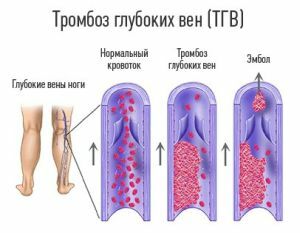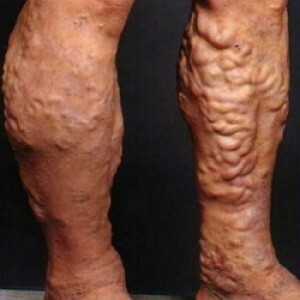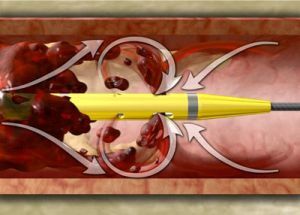 Deep venous thrombophlebitis is a disease that is the formation of blood clots in the region of deep veins( mainly manifested in the pelvic region, hips and lower leg), complicated by inflammation of the venous wall. Most often, the disease affects the lower limbs.
Deep venous thrombophlebitis is a disease that is the formation of blood clots in the region of deep veins( mainly manifested in the pelvic region, hips and lower leg), complicated by inflammation of the venous wall. Most often, the disease affects the lower limbs.
DVT( deep vein thrombosis), against which thrombophlebitis develops, is recognized as one of the most dangerous diseases, because the thrombus most often breaks off due to muscle contraction. When there is swelling of the extremities and a rise in temperature on the site of the affected area of the vein, you need to consult a doctor without delay.
Contents
- Features of the disease
- Causes and factors provocateurs
- Types of the course of the disease
- Acute course
- Chronic stage
- Features of the general clinical picture
- Diagnostic procedures and analyzes
- Medical assistance
- Preventive measures
- What is the danger?
Features of the disease
According to statistics of the World Health Organization, in 80% of patients with deep vein thrombophlebitis,
 disease passes without any visible symptoms.
disease passes without any visible symptoms. However, even in such cases the probability of trombosis is very high.
The danger is that the floating thrombus can move through the heart through the blood vessels, getting into the vessels of the lungs and, subsequently, blocking them.
The patient experiences acute pains, an inflammatory process develops in the local venous system, puffiness develops, - phlebitis of superficial veins develops.
The main feature of the disease is that as a result of the violation of the balance of the anticoagulant and coagulating circulatory system, the thrombus can not resolve naturally, but remains and closes the vessels. Most often, DVT is diagnosed on the shin area. Half of the patients turn to the doctor with pain in this area.
Causes and factors provocateurs
One of the most common causes of the disease is damage to the vein wall as a result of chemical, infectious, allergic or traumatic effects.
Excessive use of drugs, infection, the presence of allergies or fractures can disrupt the venous system and blood flow in general. Also, overweight( venous stasis), autoimmune diseases( bleeding disorders) or malignant tumors can indirectly affect.
In some cases, deep vein thrombophlebitis may appear due to natural factors: irregular daily routine( decreased activity), age or pregnancy.
The problem is that in such situations, the viscosity of the blood increases significantly. And if the walls of the venous system are obstructed, the probability of a thrombus is dramatically increased. Sedentary lifestyle, lack of mobility or excessive workload, prolonged bed rest are risk factors for the development of deep vein thrombosis.
Types of the course of the disease
By the nature of the disease thrombophlebitis is divided into three main groups.
- acute ( rapid development of the disease, vivid symptomatology);
- chronic ( slow development of the disease, mild symptomatology)
- migrating ( the disease manifests itself in several places at a time);
Two types of DVT are distinguished in appearance:
- white ( thrombosis of the iliac and femoral veins);
- blue ( recurrent thrombophlebitis).
Acute Current
 Acute thrombophlebitis of the deep veins of the lower extremities has pronounced symptoms since the onset of the disease - the presence of acute pain along the blood flow of the affected vein. The skin changes its natural color to dark red( blue later on).
Acute thrombophlebitis of the deep veins of the lower extremities has pronounced symptoms since the onset of the disease - the presence of acute pain along the blood flow of the affected vein. The skin changes its natural color to dark red( blue later on).
Despite the elevated temperature in the affected area, the entire limb remains cold. Complication with acute DVT is thrombophlebitis ischemic or gangrenous.
The pain increases every time, and the swelling increases, acquiring a purple hue. As a treatment used warming ointments, semi-alcohol compresses, drugs to improve blood circulation microcirculation, painkillers. The faster the treatment starts, the faster the painful spasms will be.
Chronic stage
Chronic thrombophlebitis has a periodic flow pattern and has no external signs and symptoms. Most often manifested after the termination of the load.
Swelling in size and pain is negligible( many of them are simply ignored).When treating specialists recommend special warming ointments and oils, elastic stockings with compression, magnetotherapy, exercise therapy and physiotherapy.
Features of the general clinical picture of
Each patient, depending on the current stage of deep vein thrombophlebitis, has various symptoms. So, if one has a pronounced edema, then the other can only have redness on the skin area.
However, the specialists developed a certain list of symptoms that can be observed in all patients who have been diagnosed with the disease:
- a rise in temperature within 37.5-38 ° C;
- hyperemia in the form of bands;
- lesion of the trunk of the saphenous vein;
- tumor development;
- pain syndromes.
It should be noted that the above symptoms indicate a possible presence of the disease. Ultimately, all determine the research and analysis of the patient.
If changes in the blood are observed or changes were found in the venous system, the patient, depending on the state of well-being, is referred for appropriate treatment.
Diagnostic procedures and analyzes
In order to diagnose, a whole complex of studies and analyzes is performed:
- ultrasound dopplerography;

- phlebography;
- radionuclide scanning;
- rheovasography of the lower limbs;
- test of Opitz-Ramines( slightly above the knee is applied an inflated cuff of the sphingomanometer to 150 mmHg),
- impedance plethysmography;
- Moses test( squeezing the shin in front and behind the palms);
- Homansa test( patient in a lying position with half-bent legs in the knees trying to rotate the foot);
- test of Lovenberg -( on the lower leg, an inflated cuff is applied).
The diagnosis is made by a phlebologist, depending on the research data. It is he who will make the decision to send the patient to hospitalization.
Medical care
Patients with suspicion of deep vein thrombophlebitis are hospitalized without fail. First, the specialist will perform an examination and ask some questions to the patient. In the future, studies and analyzes will be assigned that will allow a more detailed study of the current state of the venous system.
In the process of investigation, a pathogen will be found that prevents the body from breaking a blood clot. To diagnose the venous system, they resort to impedance plethysmography( search for thrombus localization), ultrasound examination of the affected limb, phlebography of the affected limb( vein study), and scan with fibrinogen isotopes.
 After this, the patient will receive Heparin( within a week) and Warfarin( for 6 months).In the case when the disease occurs in late complicated stages, a thrombectomy is recommended.
After this, the patient will receive Heparin( within a week) and Warfarin( for 6 months).In the case when the disease occurs in late complicated stages, a thrombectomy is recommended.
After hospitalization, passive treatment will follow: wearing compression stockings and taking anti-coagulation drugs that are included in any complex of therapy for thrombophlebitis of deep veins. It is recommended to observe bed rest and regular check-up of the doctor. Further treatment at home should be conducted for at least 10 days.
In cases where a patient undergoes a severe surgical operation, specialists prescribe anticoagulants. In addition, it is necessary to knead the affected limb without any load( just move it in the joints), massage the soft tissues.
It is worth to refuse from a sports load - it is possible to damage both the walls of venous vessels and the violation of blood flow. It is worth paying special attention to your own feelings.
Any discomfort, pain or change in the appearance of the limb is a good reason to consult a doctor immediately. Before going on long trips also it is necessary to consult with a specialist about further treatment.
Preventive measures
Specialists prescribe the following preventive actions for those who are at risk:
- small physical activities( swimming, walking);

- complex exercises exercise therapy( "bicycle", "scissors", etc.);
- adherence to a strict diet of the 3rd category;
- constant monitoring of well-being, appearance, sensations and weight;
- to exclude as much as possible the appearance of colds;
- refusal of alcoholic beverages and tobacco products;
- as often as possible to be outdoors( abandon bed rest, if it allows well-being).
It is better to take medications that are not included in the treatment course with a specialist.
What is the danger?
Deep vein thrombophlebitis can provoke complications in the operation of the venous system, including chronic venous insufficiency.
There is a possibility of a trophic ulcer, lipodermatosclerosis or eczema. The most dangerous thing that can cause DVT is thromboembolism of the pulmonary artery. In this case, as a result of a large number of PE, the patient risks getting a lung infarction.
Deep vein thrombophlebitis is a disease that can not be ignored. According to the Russian Ministry of Health, 240,000 people fall ill in one year. Every year around the world, DVT is diagnosed in 160 people for every 100 thousand people.
The female half of the population is about 5-6 times more likely to suffer from the disease than the male. Also, experts note that a thrombus is formed several times faster in people older than 40 years and obese 3 to 4 degrees. There are exceptions, but, as a rule, on the general background, their number is incommensurably small.
